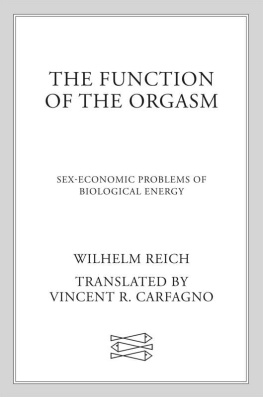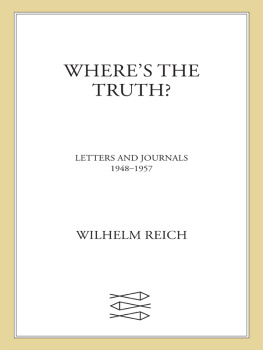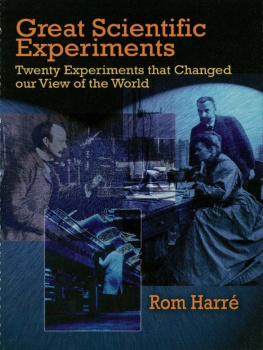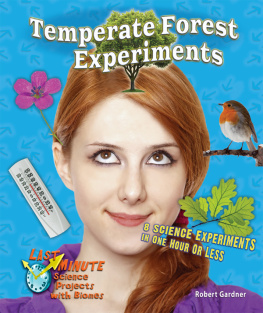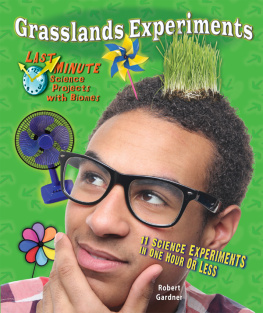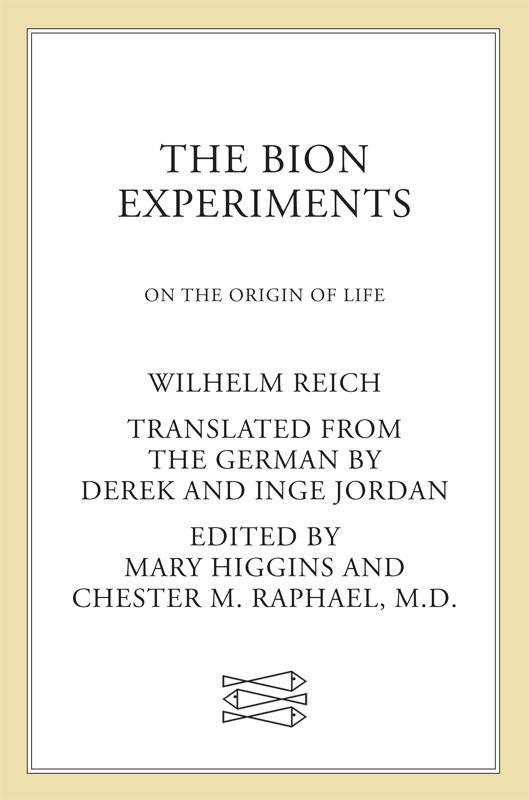
The author and publisher have provided this e-book to you for your personal use only. You may not make this e-book publicly available in any way. Copyright infringement is against the law. If you believe the copy of this e-book you are reading infringes on the authors copyright, please notify the publisher at: us.macmillanusa.com/piracy.
Contents
Love, work, and knowledge are the wellsprings of our life. They should also govern it.
WILHELM REICH

Editors Note
The Bion Experiments is Wilhelm Reichs detailed account of his laboratory investigations on the origin of life. Published originally in Oslo in 1938, it set off shock waves of indignation and controversy culminating in a savage newspaper attack that made Reichs continued sojourn in Norway impossible and caused the dismissal of his collaborator, Professor Roger du Teil, from his university position in France.
The protest that greeted these experimental findings and the report itself were soon drowned out by the Second World War, and although Reich summarized the results of his experiments in a later work, The Cancer Biopathy, full information has not been available.
In preparing this new edition, we have been torn between our wish to carry out instructions written by Reich in 1947, from the vantage point of his knowledge ten years after the completion of this report, and our concern for historical accuracy. He wrote: The philosophical article of du Teils should be left out of the reprint of Die Bione. It will be necessary to add a preface to [the] publication of Die Bione which would point out the progress made in orgone research since its first publication, and, most important of all, to change the term dialectic materialism to energetic functionalism which it truly and really is. I could no longer afford, as I did ten years ago, to have my method of thinking and research termed dialectic materialism, since (1) the socialist and communist parties are still using the term without giving it any meaning; (2) I dont wish any more to be confused with the Marxist political parties; and (3) energetic functionalism of today has as much to do with dialectic materialism as a modern electronic radar device with the electric gas tube of 1905.
The article by du Teil has been omitted, but we found it impossible to change the term dialectic materialism without creating serious confusion and damaging the integrity of the work. It therefore remains as Reich used it at this period of his scientific development. The reader should be reminded, however, that Reichs continued exploration of the path opened up by these early bion experiments led to his discovery of biological energy, the orgone, and enabled him to develop his formulation of dialectical materialism derived from Engels into energetic, i.e., orgonomic, functionalism.
Mary Higgins
Chester M. Raphael, M.D.
Forest Hills, N.Y., 1978
Preface
It is with some trepidation that I make known these experimental findings on the origin of vegetative life. It is not that I am worried about the correctness or accuracy of the data given, even though here or there an insignificant error or an awkward phrase may have crept in. All the findings described in this comprehensive, yet not definitive, report were confirmed hundreds of times. I have omitted any observations that were not verified and I have gone to great lengths to describe the method as precisely as possible, so that it can be tested by others. If the instructions are followed more or less correctly, it is impossible to miss the basic phenomena such as the vesicular disintegration of matter upon swelling or the culturability of the bions. I fully realize that the same findings are open to other interpretations than my own. For this reason I have carefully separated the factual report in Part One from the interpretation in Part Two.
I am concerned that I might be criticized as immodest for drawing the conclusions that I do from these experiments. I stayed within the bounds laid down by eighteen years of clinical work on the functionally diseased organism and ten years of intensive study of the relevant biological and physiological literature. The sections on colloids and on the dialectical-materialistic method of research were finished many years ago but lay unpublished in my desk drawer. They represented attempts to link my practical experience as a psychotherapist with my general biological studies. I had become directly aware of the connection with psychoanalytic knowledge, on the basis of my orgasm theory, when in 1926 I was asked to review a book by Fr. Kraus on the pathology of personality ( Syzygiologie ) for a scientific journal.
I did not suspect that ten years later I would be given the opportunity to verify natural philosophical assumptions and the dialectical-materialistic method in such a way, although I knew, of course, that the orgasm theory touched on the life problem. What I submit here is not a random discovery, but a development over a period of years of work on the problem of the autonomic function. Step by step the fundamentals of a theory of biogenesis, which had to be worked out in full, were revealed. I have to admit that the facts I discovered seemed incredible at first. But fact after fact came to light and each one confirmed the picture that I had already formed from clinical studies of the life function and its disturbances. By the time I published Experimentelle Ergebnisse ber die elektrische Funktion von Sexualitt und Angst in 1937, the results of the bion culture experiments were already available. Now that I have decided to publish them, I have at my disposal additional data in a related area which confirm and represent a continuation of these experiments.
The techniques which I used in the experiments do not differ from those customarily employed for bacteriological sterilization. However, the arrangement of the experiments as well as the methods of interpretation and the conclusions that are drawn differ considerably from the norm. The experiments were all based on the fundamental formula which I had discovered in the course of my research in the field of sexuality. The analytic method follows the laws of dialectical materialism. Marx had added the element of materialism to the Hegelian dialectic, but the method was first used in a natural scientific context by Engels; it then found a new application in psychology and the process of sexuality. The principles of the method became more refined and new ways of obtaining knowledge were revealed as, for example, in the dialectical-materialistic law of development. From Freud I adopted the hypothetical equation of life impulses and sexual impulses. Once I had succeeded in refuting his theory of the death instinct and in developing my orgasm theory, I was able to proceed to experimental biology. The experimental proof of the identity of the sexual energy process and the life energy process is thus simultaneously a confirmation of Freuds hypothesis.
At this point I would like to express my warmest thanks to Professor Roger du Teil for the incomparable friendship he has given me throughout our collaboration. Whatever effect his efforts to draw the attention of biologists and bacteriologists to this work may have, his active participation in the experiments has become an organic part of the entire series of studies. This is clear from the text that follows.
I am also aware that the experimental solution of the question of spontaneous generation satisfies many needs throughout the scientific world. Similarly, I know that I will have to face some sharp opposition. However, the back and forth of argument and counter-argument constitutes the very essence of scientific work. What is more, every objection leads to progress if the fundamental problem is correctly grasped.


